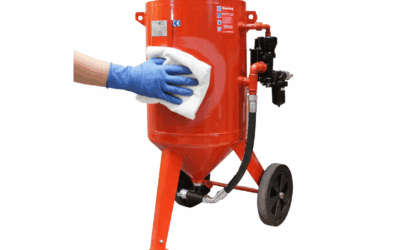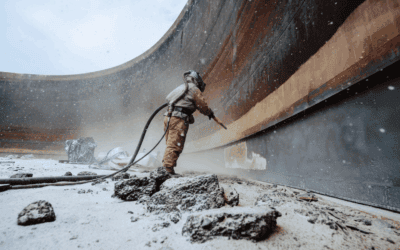Surface preparation: An in-depth guide
Effective surface preparation is the foundation of successful coating and painting applications. Whether you’re working in aerospace, marine, or structural steel industries, choosing the right method ensures proper adhesion, durability, and performance. This guide explores key techniques like abrasive blasting, direct abrasion, and advanced technologies to help you make informed decisions.
What is surface preparation?
Surface preparation involves cleaning, profiling, and conditioning a surface to improve adhesion and ensure the longevity of coatings or finishes. It removes contaminants like dirt, grease, rust, and old coatings while creating the necessary surface profile for new materials to bond effectively.
Why is surface preparation important?
Proper surface preparation ensures:
- Better adhesion: A well-prepared surface allows coatings to bond effectively, reducing the risk of peeling or flaking.
- Enhanced durability: Removing contaminants prevents issues like corrosion, improving the longevity of the coating.
- Quality finish: Preparation eliminates imperfections, resulting in a smoother and more visually appealing outcome.
Surface preparation standards
Surface preparations standards exist to maximise coating life and minimise costs. In the UK, industry standards adhere to BS EN ISO 8501-1 and SA code’s, the ISO pictorial standards for abrasive blast cleaning – specifying a series of rust grade and preparation grades of steel surfaces.
The standard grades of cleanliness for blast cleaning in accordance with BS EN ISO 8501-1 are:
- Sa 1: Brush off blast cleaning
- Sa 2: Commercial blast cleaning
- Sa 2½: Near white blast cleaning
- Sa 3: White metal blast cleaning
Factors that can affect surface preparation
- Surface material/condition: Substrate type determines suitable methods.
- Required profile: Coatings may demand specific surface roughness.
- Environmental impact: Waste and emissions may limit method options.
- Operator expertise: Skill level influences method suitability.
- Budget: Costs of methods, materials, and labour impact choices.
Surface preparation methods
Abrasive blasting
Abrasive blasting involves propelling abrasive materials under high pressure to clean or profile surfaces. There are two main types:
- Dry abrasive blasting: This traditional method uses compressed air to blast abrasive media such as steel grit, aluminium oxide, or garnet at a surface. It is highly effective for removing rust and old coatings. See our range of abrasive blast machines here.
- Wet abrasive blasting: Similar to dry blasting but with the addition of water to suppress dust and reduce heat generation. This method is ideal for sensitive environments where dust control is essential. See our range of wet blasting equipment here.
Dry abrasive blasting can generate significant dust and debris, which may impact both efficiency and safety. An effective abrasive media recovery system helps counter these challenges by efficiently recovering and reusing media, reducing waste, and maintaining a cleaner work environment. Explore our abrasive recovery systems here.
When performing any type of blasting, it’s essential to wear appropriate personal protective equipment (PPE). Browse our range of PPE suitable for blasting here.
Explore our selection of abrasive media here.
Direct abrasion
Direct abrasion involves physically grinding or sanding a surface to remove coatings or imperfections. Common tools include sanders, grinders, and wire brushes. It is often used for smaller areas or as a preparatory step before applying additional treatments. Like with dry abrasive blasting, this can also generate dust and debris, so an abrasive media recovery system would be beneficial for this set-up.
Ultra-high-pressure (UHP) water jetting
UHP water jetting is a high-pressure cleaning method that effectively removes coatings, corrosion, and contaminants without damaging the underlying structure. This eco-friendly technique eliminates the need for abrasive media and uses minimal water, making it both efficient and sustainable. Unlike other cleaning methods, UHP water jetting does not rely on high heat, making it suitable for a wide range of applications, including marine, energy, and heavy industrial sectors. See our range of UHP equipment here.
Dry ice blasting
Dry ice blasting is a form of carbon dioxide cleaning that uses dry ice pellets accelerated in a pressurised air stream to clean surfaces. Unlike other blasting methods, dry ice blasting is non-abrasive, non-conductive, non-flammable, and non-toxic. It leaves no secondary waste or chemical residue, as the dry ice sublimates upon impact, making it an eco-friendly and efficient cleaning method.
Shot blasting machines
Shot blasting machines use centrifugal force to propel steel shot against the surface. This technique is highly efficient for cleaning and profiling large, flat areas like concrete floors. It is also effective at preparation of components with repeated shapes. Shot blasting machines are also used for peening, which strengthens the surface by inducing compressive stress. See our range of shot blasting machines here.
Acid pickling
Acid pickling involves immersing metal parts in an acid solution, such as hydrochloric or sulphuric acid, to remove rust, scale, and oxides. Acid pickling is normally only used for structural steel intended for hot-dip galvanising. Safety precautions are essential due to the hazardous nature of the chemicals.
Chemical cleaning
Chemical cleaning involves applying solvents or detergents to dissolve grease, oil, or contaminants. This method is often used in conjunction with other surface preparation techniques to ensure surfaces are free of residues that may affect coating adhesion.
Comparing surface preparation methods
Selecting the best surface preparation method depends on material type, contaminants, environmental factors and the desired surface profile. Below compares the methods that are discussed above.
| Method | Best for | Key benefits | Some considerations |
| Dry abrasive blasting | Rust, old coatings, heavy contamination | High efficiency, versatile media options | Generates dust, requires PPE |
| Wet abrasive blasting | Dust-sensitive environments | Reduces dust, cools the surface | Requires water disposal management |
| UHP water jetting | Removing coatings, eco-friendly cleaning | No abrasive waste, minimal damage | High equipment cost |
| Dry ice blasting | Sensitive or delicate surfaces, eco-friendly cleaning | Residue-free, non-abrasive | Higher operating cost |
| Shot blasting machines | Large surfaces, structural steel | Fast and uniform cleaning | Requires specialised equipment |
| Acid pickling | Metal parts, scale removal | Thorough removal of rust and oxides | Hazardous chemicals |
| Chemical cleaning | Grease, oil, light contamination | Simple and effective | May require additional cleaning steps |
Surface preparation process
Follow these steps to ensure effective preparation:
- Assess the surface and identify requirements.
a) Degrease or clean workpiece (if required). - Transport workpiece to designated blasting area or facility.
- Abrade workpiece to remove corrosion or other imperfections.
- Abrade substrate to desired profile and finish for optimal coating adhesion.
a) Treat processed workpiece with chemical pre-treatment (if required). - Spray coat workpiece.
Conclusion
Surface preparation is an essential step in achieving durable, high-quality finishes. Whether you choose abrasive blasting, direct abrasion, or a specialised method like UHP water jetting or shot blasting, selecting the right technique for your project ensures optimal results. Investing time and resources into preparation will always pay off in the long term, guaranteeing the success of your coatings and treatments.
Ready to take the next step? Explore our surface preparation solutions, including blast machines, PPE, and accessories. Need advice? Contact our team of experts today for personalised recommendations.



